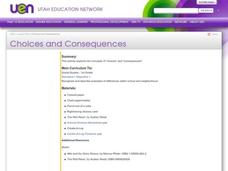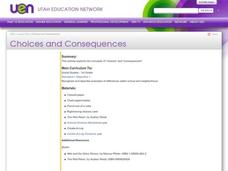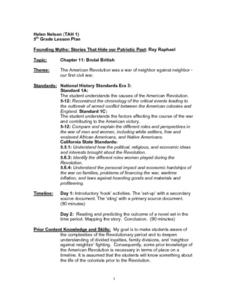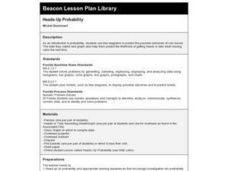Curated OER
Choices and Consequences
First graders read "The Red Racer" by Audrey Wood. They identify choices and consequences present in the story. They identify and evaluate choices, and the consequences of those choices, in everyday life both at school and home.
Curated OER
Choices and Consequences
First graders explore the relationships between the choices one makes and the consequences that follow. The importance of choices in context of getting along with others is stressed throughout the instructional activity.
Curated OER
My Community Book
Young learners examine different places in their neighborhood using informational texts. First they identify a place that they like to play and predict if it will be in the nonfiction book Community at Play.They will share their favorite...
Curated OER
Mary's Choice: To Go or Stay?
Learners read about Mary Jemison and her decision to stay in her adopted Indian culture or return to her native culture. In this Pennsylvanian history lesson, students read about the true story of Mary Jemison's kidnap as well as her...
Curated OER
Whose Fate at the G-8?
Young scholars explore the 2005 Group of 8 Summit, investigating the member countries' views on the summit issues, as well as the views of the African Union and G-8 protesters. They offer predictions on outcomes of the summit given this...
Curated OER
Brutal British
Students read and predict the outcome of a story set during the Civil War, then map the story. To prepare for the activity, students determine why it is important to look at historical events from all angles by using primary and...
Curated OER
The Civil War--Reading on the Internet
Students grasp how to read from text and retain it. They use reading comprehension strategies specific to the Internet. They search for answers to questions related to the Civil War.
Curated OER
The Drum
Students complete a variety of activities related to the folktale from India, "The Drum." They listen to the story and answer comprehension questions, construct a coffee can drum, and complete a phonics and matching worksheet.
Curated OER
Past v. Present: Using Geography & Anthropology
Students examine artifacts and documents from their Canadian community. They analyze early Canadian history and make predictions about the future of the country.
Curated OER
Population Pyramids
Students work with and make population pyramids. In this population pyramid lesson, students use census data to make population pyramids for China, India, and the United States. They use the information to determine why jobs are leaving...
Curated OER
Bizarre Food
Students research foods from other countries. In this multicultural food lesson, students view a list of foods that kings and queens ate on an overhead transparency and go to the website www.jamessolheim.com/teachers1.htm to read about...
Curated OER
Understanding James Madison The Father of the Constitution
Students research James Madison and create a table of his strengths and weaknesses. In this James Madison instructional activity, students read Jean Fritz's, The Great Little Madison, while developing their research skills, vocabulary...
Curated OER
Holy Mole
Students discover Mexican culture by reading and cooking. In this Central American History lesson, students read the book Holy Mole, and analyze the story by answering questions about plot, characters and even sound effects they...
Curated OER
The Artist As Entrepreneur: VARA-visual Artists Rights Act
High schoolers read case studies of artists' lawsuits under the Visual Artists Rights Act and then discuss the merits of fictitious cases where artists might consider a lawsuit. They predict the outcome of a lawsuit scenario and justify...
Curated OER
Plum Stone Dice Game
Young scholars read about a Native American dice game online. They make replica games, and practice playing with them. They predict the outcome of the dice rolls by completing a dice throw chart.
Curated OER
Changing Climate, Changing Animals
Students review teacher-provided background materials on impact of climate change. Students then work in small groups to make poster on possible impacts of climate change on one particular northern animal, and how it might affect people...
Curated OER
Weather "Whys" Lesson 2 Seasons
Students explore seasons. In this cross curriculum weather and seasons instructional activity, students identify characteristics of the four seasons and sequence related pictures. Students listen to poems and stories about trees in...
Curated OER
The Mughal Empire in India
In this Mughal Empire worksheet, students predict the outcomes of nine different events, then identify the Mughals as well as their cultural legacy.
Curated OER
Going West
Students examine the lives of early pioneers who traveled west for better opportunities. They listen to story "Josafina and the Story Quilt", and discuss hardships encountered by traveling families. Students then complete research and...
Curated OER
Canada Arrives in a Splash of Color
Students investigate social and political issues surrounding founding of Canada and compare their relevance to Canada today, interpret art works representing Canada's past identity and compare that identity to how Canada is perceived...
Curated OER
Cloudy With A Chance of Meatballs
Third graders read the book, Cloudy with a Chance of Meatballs." Using the internet, 3rd graders research weather conditions, plants, animals and foods from different countries. After sharing information, they discuss similarities and...
Curated OER
Scenic Attractions in Four Corners
Fourth graders find and list scenic attractions in SE Utah and the Four-Corners-region. They identify geographic characteristics of Utah and other states in the western region of the United States. They review cardinal directions and...
Curated OER
Brother Against Brother
Eighth graders read Across Five Aprils and correlate it to a unit on the Civil War. They culminate the unit by writing a a piece of historical fiction in the first person entitled "Brother Against Brother."
Curated OER
Heads-Up Probability
Second graders use tree diagrams to predict the possible outcomes of coin tosses. The data they collect and graph also help them predict the likelihood of getting heads or tails when tossing coins the next time.























